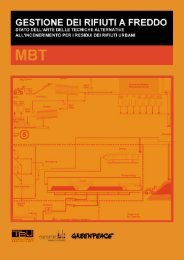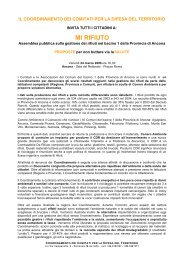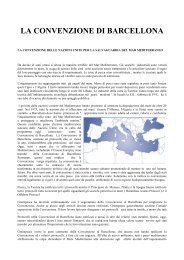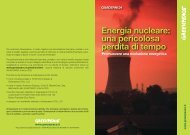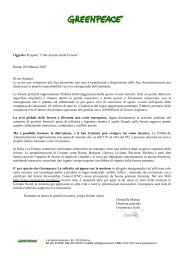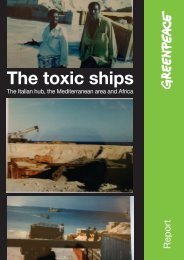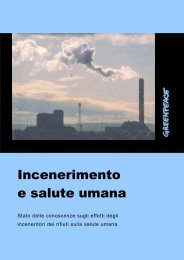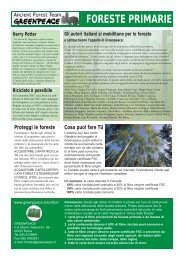Zero Waste by Robin Murray, Greenpeace Environmental Trust 2002
Zero Waste by Robin Murray, Greenpeace Environmental Trust 2002
Zero Waste by Robin Murray, Greenpeace Environmental Trust 2002
Create successful ePaper yourself
Turn your PDF publications into a flip-book with our unique Google optimized e-Paper software.
creates the problem of the safe disposal of toxic ash<br />
and of polluted wastewater; 8<br />
(ii) municipal incinerators and thermal treatment plants<br />
are not dealing with streams of a single material with<br />
a standard calorific value. There are constant changes<br />
in the composition of the waste, in its calorific values<br />
and its moisture content. This means that there are<br />
difficulties in operating these plants at the consistent<br />
combustion conditions necessary to minimise the<br />
toxicity of emissions;<br />
(iii) the inclusion of volatile substances and fluctuating<br />
highly combustible materials is one of the reasons for<br />
the regular fires, process upsets (and even explosions)<br />
that characterise incineration, and which in turn lead<br />
to large increases in toxic emissions; 9<br />
(iv) it is difficult to control the illicit introduction of toxic<br />
waste into incinerators, or of materials such as PVC,<br />
which can be major sources of dioxin when burnt.<br />
For all these reasons there has been a continuing gap<br />
between the govern m e n t ’s view of the effectiveness of<br />
incinerator pollution control via regulation and local<br />
experience of the impact of incinerators. It is a gap between<br />
ideal and ‘actually existing’ incineration. One measure of the<br />
gap is the data on re g u l a t o ry ‘exceedances’ <strong>by</strong> incinerators. 1 0<br />
Another is the epidemiological and contamination evidence<br />
of those who live near them. A third is the evidence on the<br />
h a z a rdous conditions faced <strong>by</strong> those working in incineration<br />
plants. The gap defines an increasingly intense space of<br />
e n v i ronmental politics, one that centres on information, and<br />
is engaged principally at the level of local and re g i o n a l<br />
p o l i c y, planning inquiries and elections. 1 1<br />
Landfills and incinerators have highlighted the problems<br />
of the toxicity of waste and how it has traditionally been<br />
managed. In part the new awareness can be seen as an<br />
aspect of the knowledge revolution, a result of improved<br />
measurement technology which has brought to light many<br />
longstanding problems which previously went<br />
unmeasured. But in part it is a response to the growing<br />
toxicity of modern materials themselves.<br />
In landfills the decomposition of waste leads to emissions<br />
f rom many of the 100,000 chemicals now in use in modern<br />
p roduction, while the acidifying process of biological<br />
degradation leaches out dangerous substances. Wi t h<br />
incineration, a core problem has been with those materials<br />
known to be particularly toxic when burnt (such as<br />
chlorine-based products, batteries and brominated flamere<br />
t a rdants). In each case the dangers associated with<br />
p a rticular hazardous materials are compounded when their<br />
disposal is part of a general waste stream.<br />
As these effects have been recognised, the response has<br />
been increased regulations and improved technology.<br />
Modern landfills are required to be lined, and to treat the<br />
leachate and burn the gases emitted from the sites.<br />
Incinerators in Europe have had to be upgraded with new<br />
flue gas treatment technologies, which have cut toxic<br />
emissions to air. In this, the policies to control pollution<br />
from waste are part (if a later part) of the wider<br />
regulatory history of pollution abatement which<br />
characterised environmental policy in the last quarter of<br />
the twentieth century.<br />
Yet in the case of waste, more stringent regulations have<br />
far from solved the problems. A large number of current<br />
(and past) landfill sites lack leachate and gas treatment.<br />
Those that have installed them have not been able to<br />
eliminate toxic emissions to air and water. 12 The improved<br />
flue gas cleaning at incinerators has reduced air emissions<br />
but not stopped them. There are still regular exceedances,<br />
and as we have seen there are still problems with the<br />
handling and disposal of the toxic ash. Incinerators<br />
remain generators of pollution which is dispersed widely<br />
(<strong>by</strong> design) via stack emissions, ash spreading, ash burial<br />
and water discharges.<br />
There are no reliable, risk-free technologies for waste<br />
8<br />
<strong>Zero</strong> <strong>Waste</strong><br />
9



